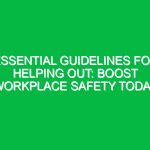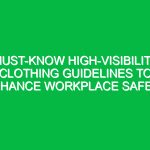“`html
Must-Know Guidelines for Managing High Hazard Activities Safely
Introduction
Good morning team,
Today, we’ll be discussing a crucial topic that impacts all of us in our daily work—Must-Know Guidelines for Managing High Hazard Activities Safely. Safety is not just a set of rules; it’s a culture that we must cultivate, especially when dealing with high hazard activities. Understanding these guidelines not only protects you but also your colleagues and the entire workplace.
High hazard activities can lead to severe injuries or even fatalities if not managed properly. By prioritizing Safety, we ensure that everyone goes home unharmed at the end of the day. Let’s dive into the essential guidelines that will help us manage these activities safely.
Understanding Must-Know Guidelines for Managing High Hazard Activities Safely
When we talk about managing high hazard activities safely, we refer to a set of protocols and practices designed to mitigate risks associated with dangerous tasks. These guidelines are essential in maintaining a safe work Environment and ensuring compliance with regulatory Standards.
Many employees may believe that accidents are unavoidable or that safety protocols are just formalities. However, it is crucial to understand that adherence to Safety Guidelines can significantly reduce the risk of incidents. In fact, most workplace accidents are preventable with proper Training and awareness.
Key Hazards, Risks, and Safety Considerations
High hazard activities encompass a wide range of tasks, from working at heights to handling hazardous materials. Here are some specific hazards and risks associated with these activities:
- Falls from Heights: This is a leading cause of injury in construction and Maintenance work. Proper Fall Protection systems must be in place.
- Electrical Hazards: Working with or near electrical systems poses the risk of electrocution. Always ensure that equipment is properly grounded.
- Chemical Exposure: Handling toxic substances can lead to serious health issues. Use appropriate Personal Protective Equipment (PPE) and follow safety data sheets (SDS).
- Machinery Risks: Operating heavy machinery without proper training can result in serious injuries. Ensure you are trained and certified to use the equipment.
Ignoring these safety protocols can lead to severe consequences, including workplace injuries, legal ramifications, and increased insurance costs. The reality is that even a moment of negligence can have life-altering impacts.
Best Practices, Procedures, & Actionable Advice
To manage high hazard activities safely, follow these Best Practices:
- Risk Assessment: Before starting any high hazard activity, conduct a thorough risk assessment. Identify potential hazards and implement Control Measures.
- Training and Certification: Ensure that all employees are adequately trained and certified to perform high hazard tasks. Regular refresher courses can reinforce this knowledge.
- Use of PPE: Always wear the appropriate Personal Protective Equipment. This includes helmets, gloves, goggles, and harnesses as necessary.
- Establish Safety Protocols: Create clear standard operating Procedures (SOPs) for high hazard activities. Ensure everyone is familiar with these protocols.
- Emergency Preparedness: Have an emergency response plan in place. Conduct regular drills to ensure everyone knows what to do in case of an emergency.
For example, let’s consider a case where a worker fell from a scaffold because safety harnesses were not used. This incident could have been avoided if proper protocols were in place and followed. Always remember, safety is everyone’s responsibility.
Regulations, Standards, and Compliance
It’s crucial to adhere to Regulations set forth by organizations such as OSHA (Occupational Safety and Health Administration) and ISO (International Organization for Standardization). These regulations provide guidelines to help reduce risks associated with high hazard activities.
Compliance with these standards is not just about avoiding penalties; it’s about ensuring a safe work environment for everyone. Regular audits and inspections can help maintain compliance and identify areas for improvement.
Employee Engagement & Discussion
Let’s take a moment to engage with one another. Think about your experiences with high hazard activities:
- What safety challenges have you encountered related to this?
- How have you managed risks in your daily tasks?
- What suggestions do you have for improving safety in our work environment?
Your input is invaluable in fostering a culture of safety. Sharing experiences can lead to learning and improvement for all.
Conclusion & Key Takeaways
To summarize, understanding and implementing the must-know guidelines for managing high hazard activities safely is essential for our collective safety. Key takeaways include:
- Conduct thorough risk assessments.
- Ensure all employees are trained and certified.
- Always use appropriate PPE.
- Establish and follow clear safety protocols.
- Be prepared for emergencies with a solid response plan.
Let’s make it our mission to prioritize safety in everything we do. Remember, a safe workplace is a productive workplace. Thank you for your attention and for your unwavering commitment to safety. Together, we can ensure that everyone goes home safe and sound every day.
“`


